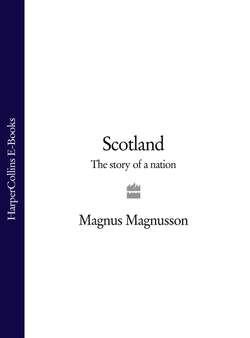Читать книгу Scotland: The Story of a Nation - Magnus Magnusson - Страница 28
Kenneth mac Alpin (800–58): the union of the Picts and the Scots
ОглавлениеOne effect of the viking incursions in the west was to force the Scots of Dalriada to look eastwards along Strathearn (‘the Strath of the Irish’) towards the richer lands of Pictish Fortriu, where the Picts, too, were under fierce pressure from viking attacks from the east. The power of Dalriada was now in decline and, despite occasional hostility between Scots and Picts, there was a certain inevitability about the way in which the two kingdoms began to come together against the common viking enemy.
This process of gradual unification culminated in the middle of the ninth century with the first joint king of the Picts of Fortriu and the Scots of Dalriada – Kenneth mac Alpin (Cináed mac Aílpín), known as Kenneth I. He was born about 800, and is believed to have been of mixed Dalriadan and Pictish stock, with a Gaelic father and a Pictish mother.
Out of the welter of warfare which saw the royal families of both kingdoms crushed, Kenneth mac Alpin emerged as king of Dalriada around 840; a few years later he became king of Pictish Fortriu as well. How exactly that came about is not known; according to a lurid folk-tale he invited the leaders of the Pictish nobility to a feast under a flag of truce and had them all slaughtered, but that yarn is no longer given any credence.
Kenneth mac Alpin soon moved his base out of Dalriada and eastward to Tayside, the heartland of Pictland itself. The island of Iona, founding centre of the Columban Church, had proved to be too vulnerable to viking raids; so when another huge viking fleet came prowling down the west coast in 849 on its way to Ireland, Iona and the other ‘hallowed’ islands were abandoned and the relics of their saints taken to safety on the mainland. The bones and treasures of St Columba were carried from Iona to Dunkeld (‘Fort of the Caledonians’), and installed in a great new church there.
It was the end of Dalriada as a historical identity. Kenneth mac Alpin, or one of his successors, established a new royal seat at Scone, near Perth, which became the capital of a united kingdom. He died in his palace at Forteviot in 858, having in the last ten years of his life invaded the kingdom of Northumbria no fewer than six times. In the course of these incursions he burned the royal fortress of Dunbar and the great early monastery at Melrose.
Kenneth mac Alpin’s unification of Dalriada and Pictland as a new political entity was a landmark in the evolution of Scotland as a single kingdom. His authority extended from the Moray Firth in the north to the Firth of Forth in the south. This kingdom soon came to be called Alba, the old Gaelic name for Britain as a whole, which was now applied specifically to the territory ruled by Scottish kings.
Kenneth mac Alpin founded the first recognisably Scottish royal dynasty, and as a result Scotland’s kings are formally numbered from him as Kenneth I. However, the perceived significance of Kenneth mac Alpin in the origins of the Scottish nation is now diminished in the eyes of modern historians. Ted Cowan backs another king as the real creator of the kingdom we now call Scotland; his name was Constantin II (Constantín mac Áeda), and he ruled from 900 to 943:
In my view, Constantín mac Áeda was Scotland’s equivalent of England’s King Alfred, and he should be on the lips of every schoolchild in this country. Perhaps the only reason that he isn’t is because his Gaelic name looks so difficult to pronounce! This Constantín did two things. First, he married members of his family into the viking war-bands and bought peace with them in that way. Second, he manufactured a new origin myth for the ‘Scots’ to give them a pedigree which showed how the Picts and Scots were related.
The ‘original’ Scottish origin myth traced the lineage of the Scoti back to Biblical times: they were descended from an Egyptian princess named Scota, the daughter of the Pharaoh of the Oppression (Ramses II, 1304–1237 BC). This enterprising princess left Egypt shortly after the Israelites crossed the Red Sea. She wandered for 1,200 years in the deserts of the eastern Mediterranean, before crossing to Sicily and making her way through the Pillars of Hercules (Straits of Gibraltar), through Spain and then across to Ireland. In her baggage she brought the block of sandstone, weighing 152 kilograms, which was reputed to have been used as a pillow by Jacob when, according to Genesis 28, he had his celebrated dream about Jacob’s Ladder (‘I am the Lord God of Abraham thy father, and the God of Isaac: the land whereon thou liest, to thee will I give it, and to thy seed’). From the east coast of Ireland, Scota beheld her own Promised Land – Scotland – and crossed over to it with Jacob’s sacred Stone.
Constantin II, according to Ted Cowan, made a significant addition to this imaginative account: he instructed his bards to give Scota a husband – Gaedel Glas (Gathelos), a Prince of Scythia and ancestor of the Picts. That gave the Picts and the Scots a common ancestry, as a deliberate part of the nation-building on which Constantin II was engaged. As part of the redefining of the new integrated kingdom, Scota’s far-travelled Stone was moved to Scone, where it was put to use as the seat on which the rulers of the united Scottish kingdom were inaugurated – the ‘Stone of Scone’ or ‘Stone of Destiny’, as it came to be called.
